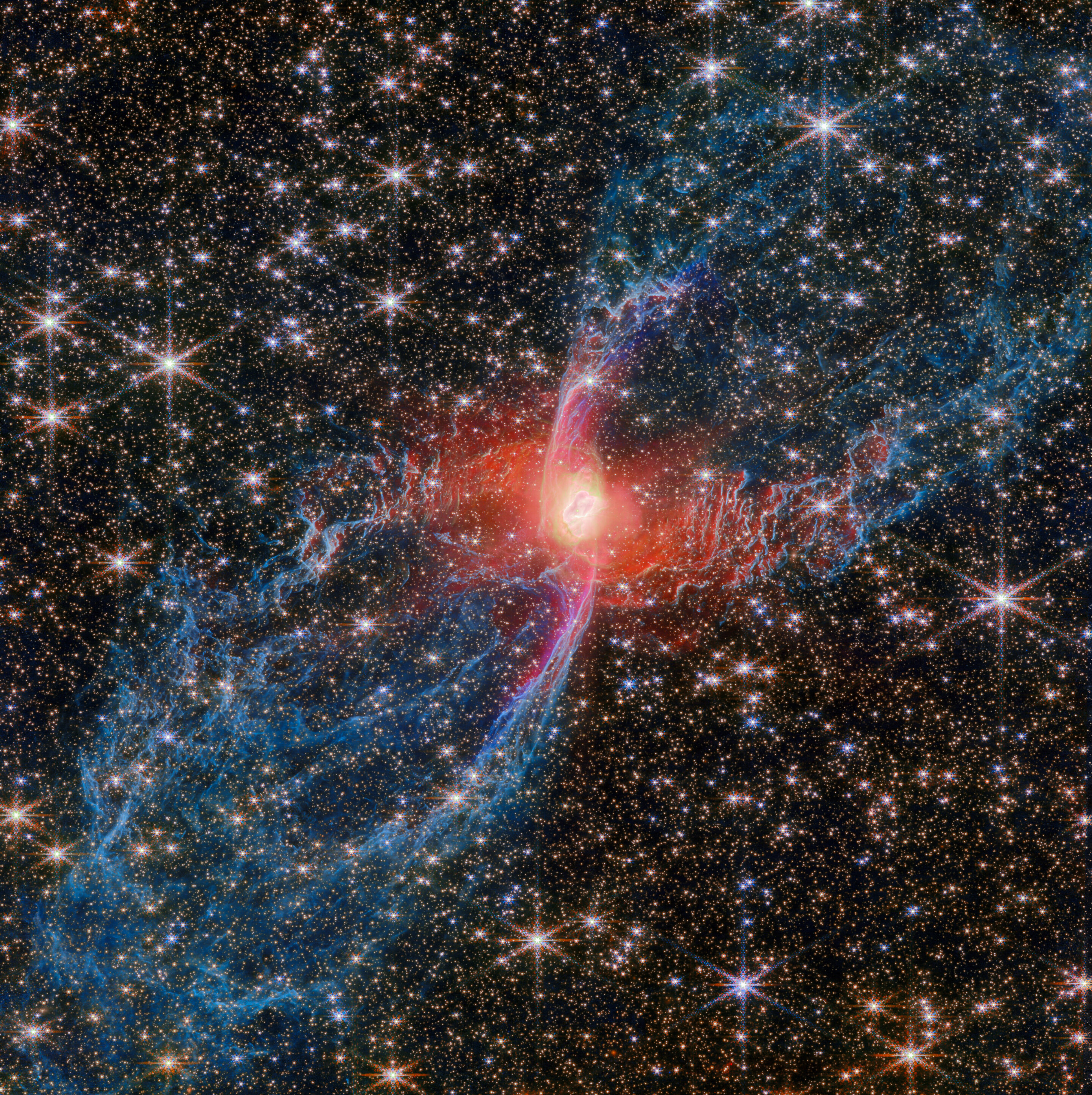🕷️ The cosmic spider as never seen before with James Webb
Follow us on Google News (click on ☆)
The image captured by the NIRCam instrument shows a planetary nebula whose central star is hidden by a pinkish cloud of dust. Intense red light emanates from this region, illuminating the surrounding materials. Two large bluish loops, consisting of fine ridges of molecular gas, extend diagonally from the center to the edges of the image. Thousands of white stars dot the background, visible through the thinner dust layers.

The planetary nebula NGC 6537 photographed by the James Webb Telescope. The central star is hidden by a pink dust cloud, while blue structures extend from the center. Thousands of stars form the background.
Credit: European Space Agency
Planetary nebulae like this one form when ordinary stars reach the end of their existence. After transforming into red giants, these stars expel their outer layers into space, revealing their extremely hot core. The ultraviolet radiation emitted by the central star ionizes the ejected matter, causing it to glow. This spectacular phase of stellar life lasts only a few tens of thousands of years, making it a relatively ephemeral phenomenon on the cosmic scale.
The central star of the nebula appears brighter than the networks of gas and dust surrounding it. Optical observations, like those made by Hubble, showed a faint blue star, but Webb's infrared vision reveals an envelope of hot dust surrounding the main star. This dust probably orbits the star in the form of a disk, explaining the reddish appearance captured by instruments sensitive to infrared wavelengths.
The extended lobes of the nebula, which form the "legs" of the cosmic spider, are now visible in their entirety. These blue structures, each extending approximately three light-years, are delineated by light emitted by hydrogen molecules. The gas escaping from the center of the nebula has inflated these massive bubbles over thousands of years, creating these closed forms that occupy the entire field of view of the NIRCam instrument.
New observations also reveal the presence of active gas jets emanating from the heart of the nebula. An elongated "S"-shaped structure, purple in color, marks the location where a fast jet emerged near the central star and collided with previously ejected matter. This interaction helped sculpt the wavy structure we observe today, gradually shaping the characteristic appearance of this planetary nebula.
The formation of planetary nebulae
Planetary nebulae represent one of the final phases of stellar evolution for medium-mass stars, like our Sun. When these stars exhaust their nuclear fuel, their internal equilibrium is disrupted, causing a spectacular expansion of their outer layers.
This transformation brings them to the red giant stage, where their diameter can increase several hundred times. During this phase, the star becomes unstable and begins to lose its matter massively into interstellar space, creating a particularly intense stellar wind.
The ejection of the outer layers gradually reveals the star's hot core, which transforms into a white dwarf. This stellar remnant then emits intense ultraviolet radiation that excites the atoms of the surrounding gas, causing the characteristic glow of planetary nebulae.
The beauty of these cosmic structures is ephemeral, as the dispersed gas eventually dilutes into interstellar space after only a few tens of thousands of years, enriching the interstellar medium with heavy elements synthesized by the star.
The importance of infrared observation
Observation in the infrared allows us to penetrate cosmic veils that remain opaque in the visible domain. Interstellar dust, which absorbs and scatters visible light, becomes partially transparent to longer infrared wavelengths.
This physical property explains why the James Webb Telescope can reveal details hidden from optical instruments like Hubble. Star-forming regions, protoplanetary disks, and the cores of nebulae, often obscured by dust, become accessible to infrared observation.
Cold objects in the Universe, such as dust at a few tens of degrees above absolute zero, emit mainly in the infrared. By capturing this thermal radiation, astronomers can study the temperature, composition, and distribution of cold materials in space.
Webb's ability to detect infrared light with exceptional sensitivity opens a new window on the Universe, enabling the exploration of previously invisible phenomena and looking further back in cosmic time to observe the first generations of stars and galaxies.